English Cathedrals
Article about the Cathedrals of England, the design, place and history and their settings for travellers curious about places such as York, Salisbury, Winchester, Ely, Chester, Canterbury or London where the church was a beacon linking the pilgrims paths as well through to Europe. This article links to understanding Britain's churches. An Antipodean travel company serving World Travellers since 1983 with small group educational tours for senior couples and mature solo travellers.
16 Sep 22 · 20 mins read

English Cathedrals
England is home to over 16,000 splendid churches, but none are more iconic and spectacular than the country’s sixty or so Anglican and Roman Catholic cathedrals. Each cathedral is the chief church of a distinct diocese, distinguished as such by containing the seat, or catehdrai, of a bishop. Standing grander than palaces, castles, or mansions, they have towered over England’s cities, towns, and countryside for over a thousand years.
The Saxons were the first people to build cathedrals in England, doing so from the seventh century onwards. All traces of these cathedrals completely vanished, however, following the Norman Conquest in 1066. Instead, in what was the most sustained building program in medieval history, the Normans rebuilt virtually all the cathedrals in their own style. Many of those we know today originate from this period.
Many of England’s finest cathedrals are also stylised in the Gothic architectural form that originally spread out from northern France. The style was prevalent from the late 12th century and continued into the 20th century, involving various periods including Early Gothic, Decorated, and Perpendicular. Many of these were restored in the 19th and 20th centuries, pulled back from decay and ruin, while several new ones were also constructed in this period in a mixture of styles including Gothic, Victorian, Neoclassical, and more.
Today England’s cathedrals continue to be a major drawcard for tourists, some attracting millions of people a year. Visitors flock to marvel at the grandiloquent architectural details, including extravagant towers, long naves, high and ornate ceilings, arched stained-glass windows, elaborate tracery, and more.
This article explores the historical background and architectural details of some of England’s finest cathedrals as background reading for Odyssey Traveller’s tours to the United Kingdom. We visit several of these cathedrals during our Seven Ages of Britain Small Group Tour and our Medieval England Small Group Tour, both designed for senior and mature travellers. Much of the information used in this article is extracted from Simon Jenkin’s book England’s Cathedrals.
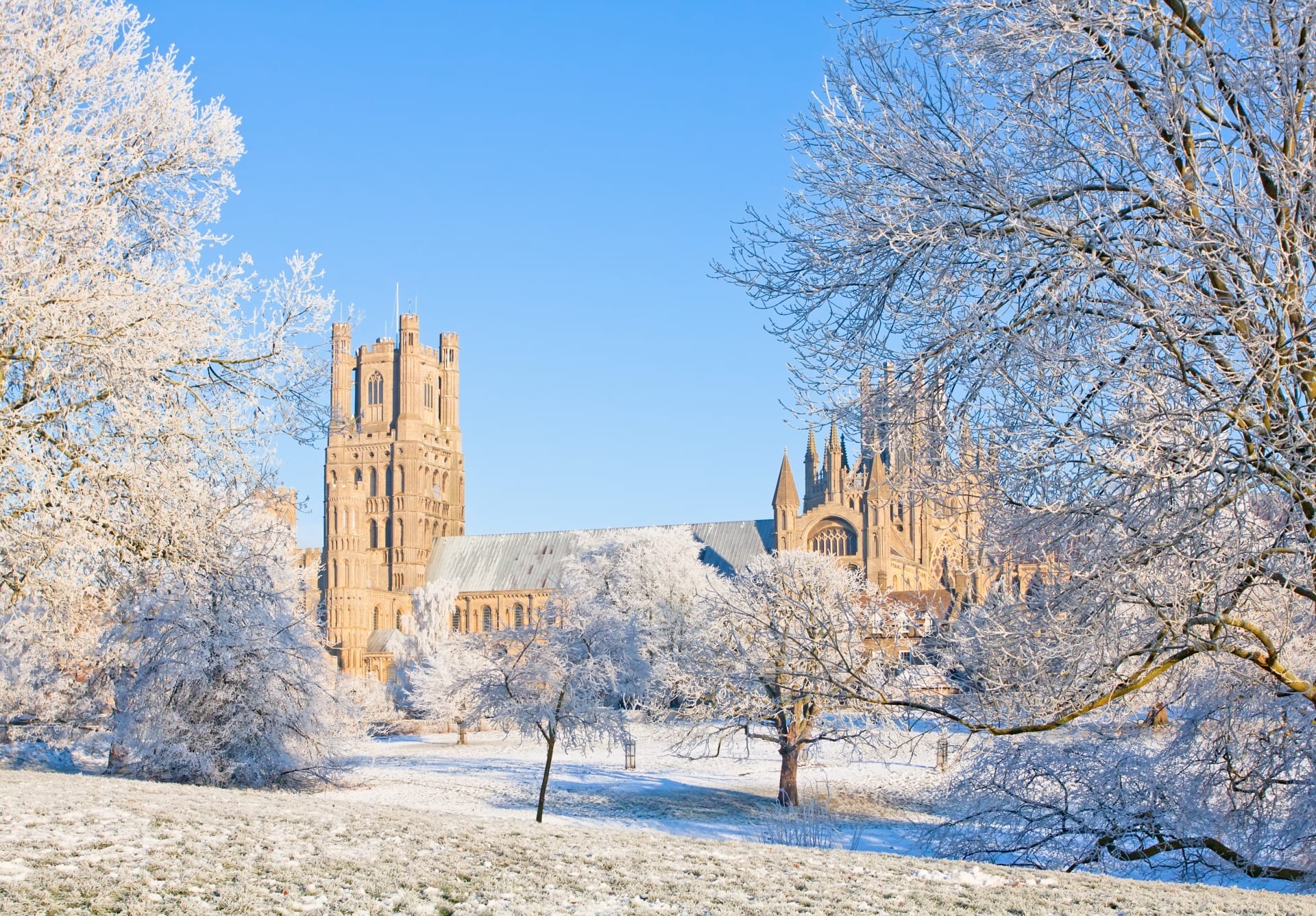
Chester Cathedral
Chester Cathedral is the mother church of the Diocese of Chester, squeezed into the centre of the old city in Chester. According to legend, the site was originally a druidical temple, before it was used for Christian worship by the Romans, and eventually became the shrine of St Werburgh under the patronage of Alfred the Great‘s daughter, Ethelfleda. In 1092, Hugh Lupus, Earl of Chester, rebuilt the church on a larger scale and established a Benedictine monastery here, filling it with Norman monks. Another rebuilding of the church began in 1250, this time in Norman Gothic style, taking over a century to complete. The monastery became a cathedral in 1541 after the dissolution of the monasteries in England.
The cathedral is built of new red sandstone, which easily eroded by rain and wind, becomes a dirty red black. Like other red sandstone cathedrals in England, Chester has therefore had to be heavily restored. The restoration took place mainly in the 19th century, with almost all of the exterior the work of George Gilbert Scott, including the tower with its odd corner turrets. The façade of the cathedral retains its medieval design, dominated by a large deeply recessed eight-light window in the Perpendicular style.
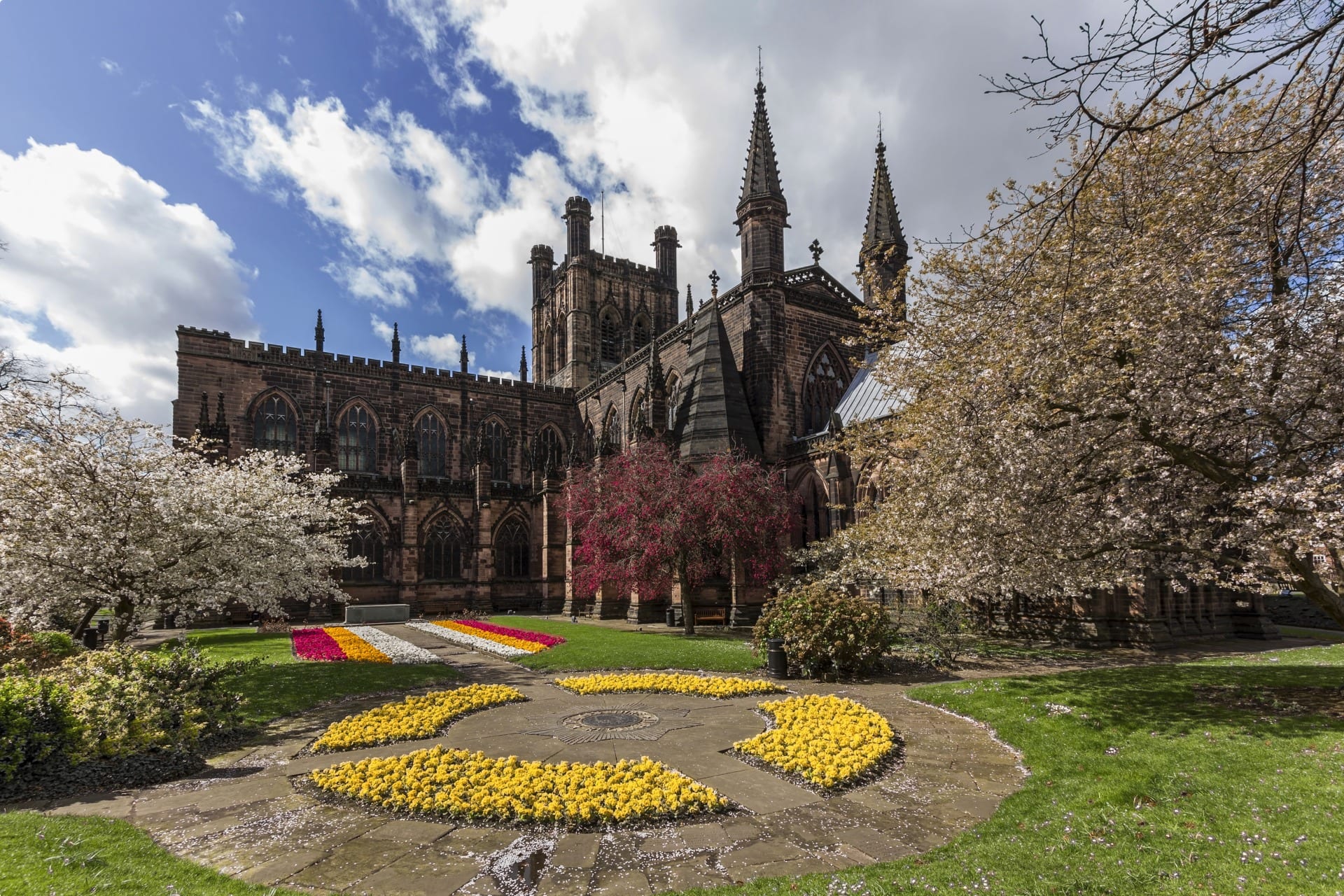
Inside, the sandstone remains a pleasant grey pink. As restored by Scott, Chester’s nave and chancel keep their 14th century coherence, with Decorated arcades forming an orderly rhythm the length of the church. The nave has a Perpendicular clerestory, while the chancel is an earlier triforium of blind arcading. The west window is a colourful 1960s work by Carter Shapland, depicting various northern saints in a cubist / medieval style against a blue background. In the north-west corner, the baptistery is framed by tall Norman arches.
The north transept contains Norman remains, with battered triforium columns reputedly salvaged form the ruins of Roman Chester. The south transept contains four chapels on its east flank in the Decorated style. The cathedral’s glory is its choir stalls, dating from the 1380s and attributed to William and Hugh Herland, the royal carpenters. The carving is intricate: below nodding ogees form miniature oriels, while above are tabernacles with tiny windows behind.
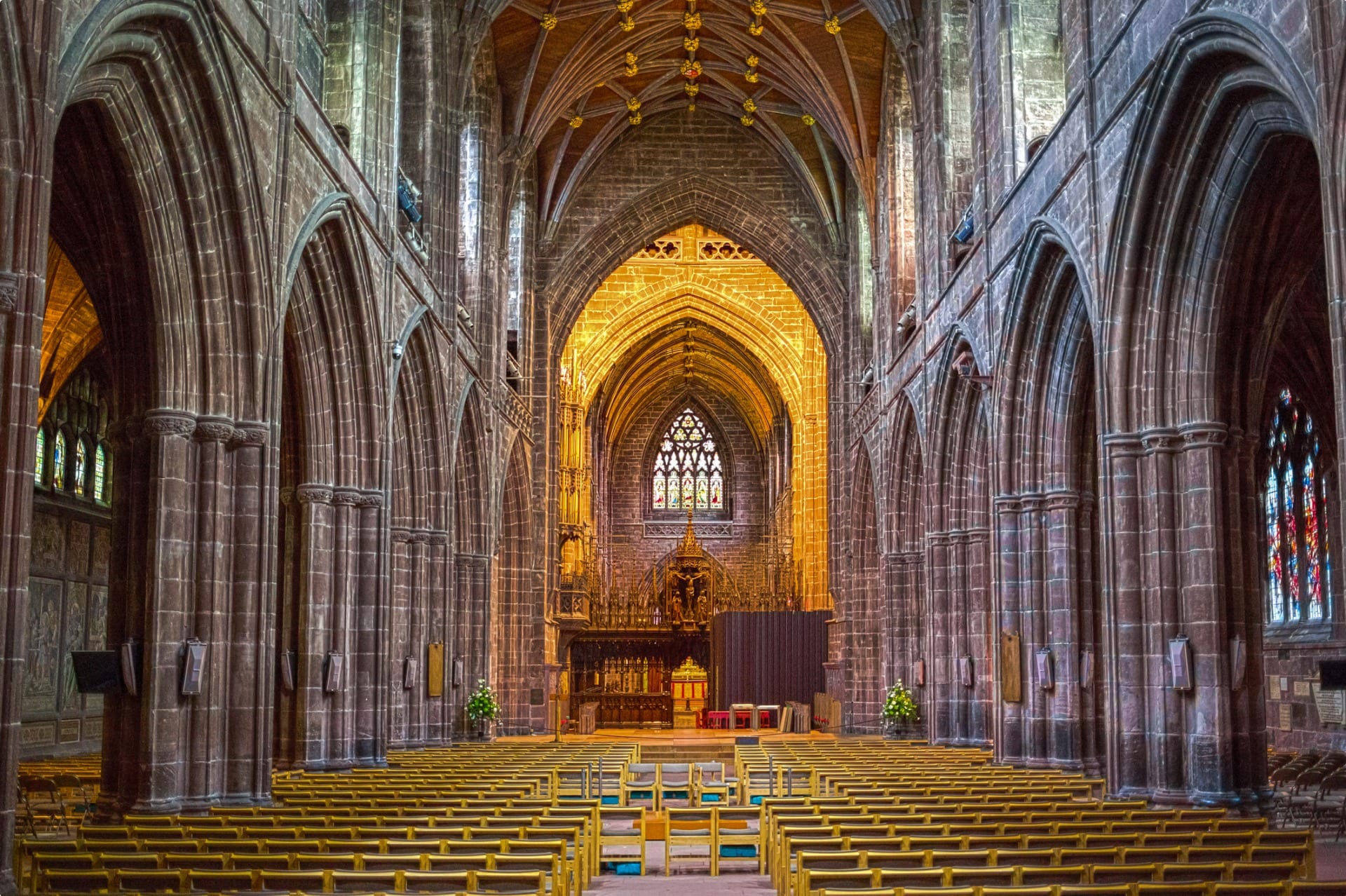
Durham Cathedral
Durham Cathedral, located in the city of Durham, is a giant amongst England’s cathedrals. It was originally the site of a church constructed in the honour of St Cuthbert, who was transported here by Lindisfarne monks in the 800s. After the Conquest, the Normans appreciated the site’s military value and supplied it with a castle, a Benedictine monastery and, from 1093, a cathedral. The cathedral was completed in just 40 years, with St Cuthbert’s shrine as its centrepiece. It was soon among the most popular pilgrim destinations in England.
The cathedral’s Norman architecture has essentially survived intact, although later additions predominate on the exterior. The main tower is a 15th century design, while the two west towers are original, each a Norman keep in miniature covered in arcading. They are spoiled only by 19th century battlements in place of what were once spires. The cathedral’s exterior was scraped in the 18th century, losing its ancient stonework and carving. Although the original stone must have been heavily eroded, we can never know what wonders were lost.
Durham’s interior, begun in 1093, is listed as a World Heritage Site. The stone ribbed vault of the nave was an important and innovative achievement for its competition date of 1135. Ribs rise to what is in effect a forerunner of a pointed arch, with the vault supported by flying buttresses hidden in the aisle roofs. Every moulded feature of the nave, meanwhile, is decorated with zig zag, covering the arcades, triforium, clerestory and main vault. The side walls are lined with blind arcading, but otherwise the nave is sculptural and spare.
The west end of the nave is dominated by a Decorated window. The choir stalls, installed in 1665, are in the gothic form, beyond which stands a grandiloquent bishop’s throne (said to be even taller than the Pope’s in Rome). Several smaller chapels are located around the edge of the Cathedral, including the Galilee Chapel, Durham Light Infantry Chapel and the Chapel of the Nine Altars. The shrine of St Cuthbert, meanwhile, is located in the east end of the church. Saint Oswald’s head and the remains of the Venerable Bede can also be found in the church.
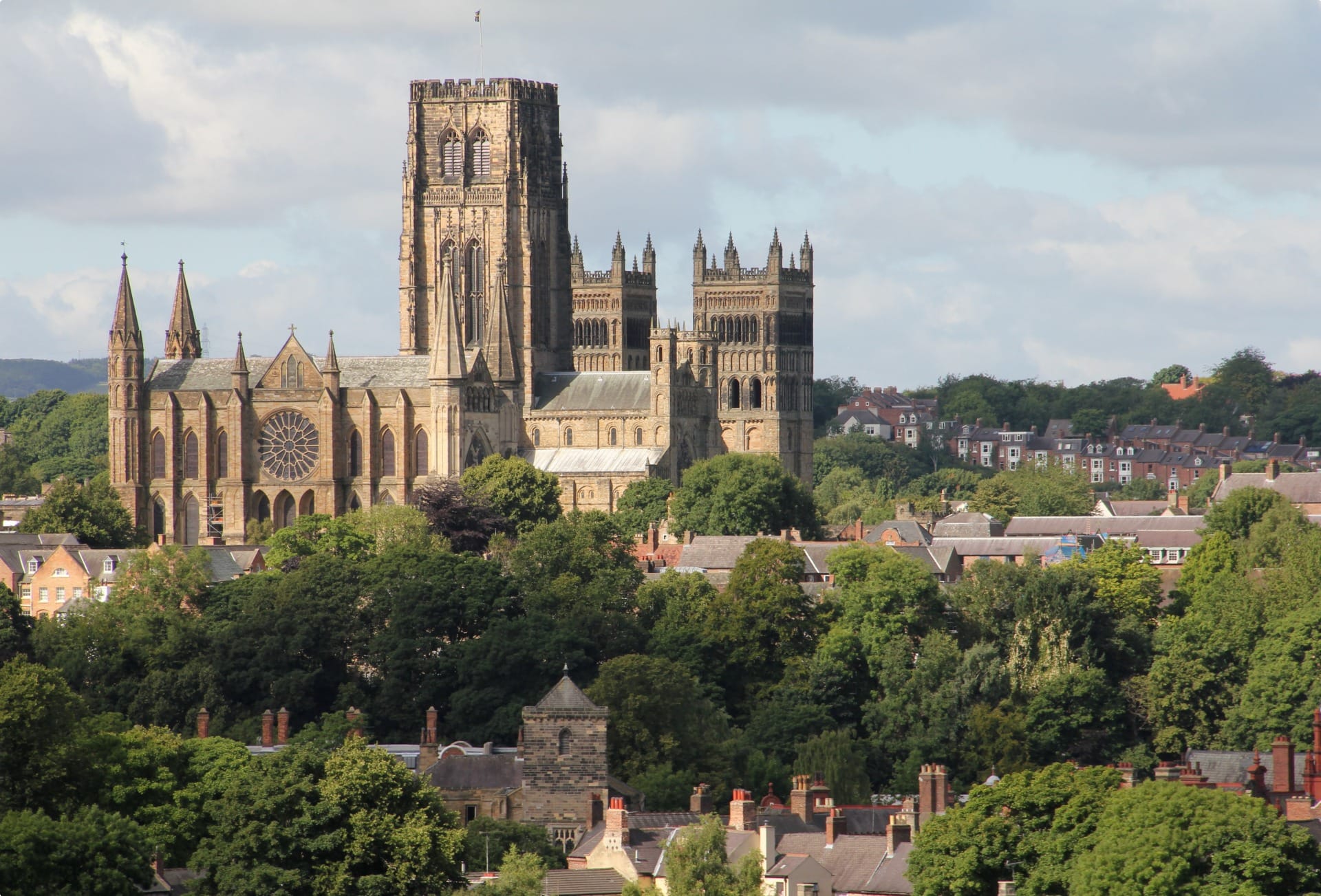
Ely Cathedral
Ely Cathedral, located in the city of Ely, Cambridgeshire, is perhaps England’s most eccentric, outstanding architecturally for both its scale and stylistic details. The cathedral’s story dates back to Saxon times, when a monastery was founded on the site by England’s first female saint, Etheldreda. Etheldreda died in 679 but her monastery flourished for the next 200 years, and her tomb became a site of pilgrimage. The monastery was destroyed by the Danes but re-founded by the Benedictines in 970. Work on the present church began in 1081 and it became a cathedral in 1109. By the end of the 12th century the press of pilgrims to Etheldreda’s shrine required expansion, leading to the rebuilding of the east end in the 13th century in the Early Gothic style.
Disasters struck in 1322, with the collapse of the crossing tower. The consequent reconstruction, however, brought Ely its most prized feature – its central octagon and lantern. Further catastrophe occurred at the end of the 14th century, with the collapse of the north-west transept and towers, but there was no money to rebuild. The three remaining towers are Romanesque architecture, displaying Anglo-Norman blind arcading from top to bottom.
The nave is framed by a tall western arch, while the vista is of a colonnade of piers and arches. Overhead is a wooden ceiling painted in warm reds and greens. At the crossing, the roof suddenly opens and a great opening soars upwards; here is the large octagonal tower, with its pinnacles and lantern above. The roof and lantern are held up by a massive oak beam, rising to a height of 63 feet. At the apex of the lantern is a painting of Christ in Majesty, surrounded by panels of angels playing instruments.
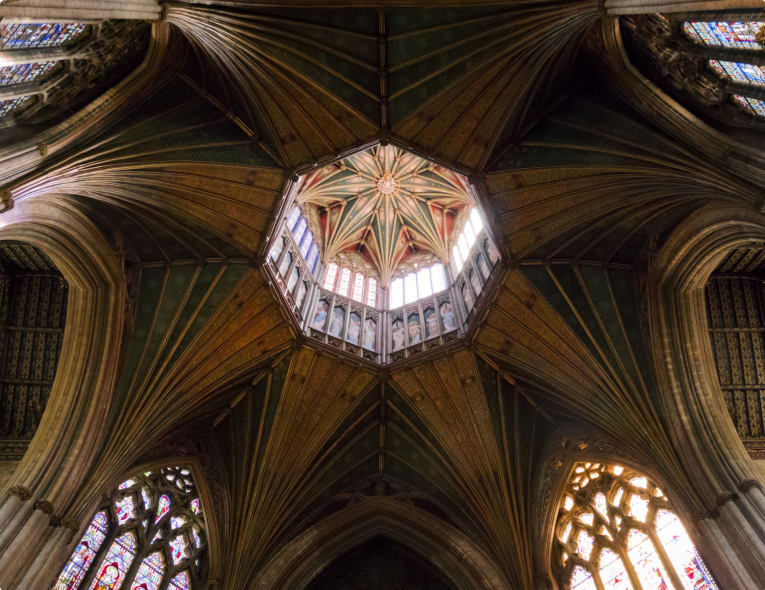
Ely has no surviving cloister or chapter house. Instead, there is a Lady Chapel. Completed in 1349, the chapel is a precious example of the Decorated style. A large window fills the west end with reticulated tracery, and the vault is the widest of the period in England at 46 feet. But the chapel’s glory is the stone seats along the walls, with their canopies undulating around the room in a continuous flowing line, voluptuously coated in leaves, crockets, and figures.
Leeds Roman Catholic Cathedral
Leeds lacks an Anglican cathedral as the Diocese of Leeds’s cathedrals are in Ripon, Wakefield, and Bradford. It does have a modest Roman Catholic cathedral, however. The cathedral was consecrated in 1904, after Leeds’s previous cathedral was demolished for road widening.
The site is restricted to a square, with just four nave bays, short transepts, and a chancel. The style is late gothic revival but with a distinctive Arts and Crafts overlay. The west façade is rugged, as if hewn from a giant slab of silver limestone. The three central windows are deep-set. The side walls are almost entirely composed of buttresses, giving the church a bombproof appearance.
The interior is stylistically eccentric. The nave piers carry gothic shafts but some rise not to the vault but to saints’ niches. Likewise, the window tracery breaks into semi-fans, faintly art nouveau. The aisles are lined with chapels. Most extraordinary is the chancel arch. The eye is drawn to the tall gothic altarpiece of gilded wood, surrounded by swaying art nouveau mosaics of saints.
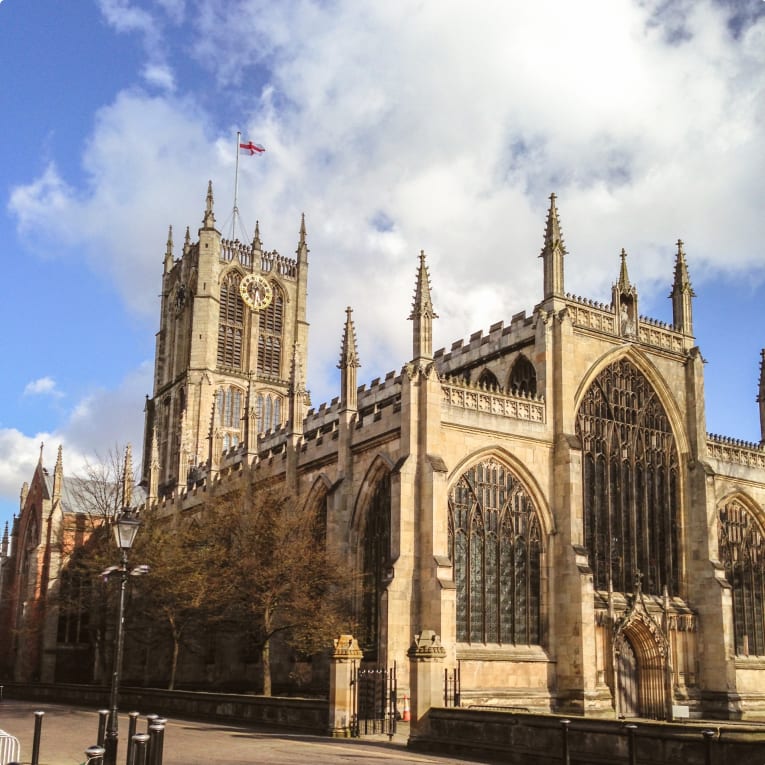
Liverpool Cathedral
Liverpool’s Anglican cathedral is the biggest church in England and the eighth biggest in the world. With a total external length of 189 metres, it is one the world’s longest cathedrals. And with a height of 101m, it also has one of the world’s tallest non-spired church buildings.
Construction of the cathedral began in 1902 based on the gothic design of Giles Gilbert Scott, grandson of the great Sir George. Scott’s design soon began to alter, notably from two towers and two transepts to four transepts and a tower. Work proceeded from east to west and was interrupted by two world wars until finally completed in 1978.
The exterior is massive, composed of chancel, transepts, buttressed walls, and pinnacles, while the tower dominates the Liverpool skyline. Inside are all the features of a gothic church: fluted piers, lierne vaults, and Decorated windows. The traditional nave is discarded for a so-called Great Space that separates two equal transepts in the heart of the building.
The cathedral is above all a celebration of arches: round ones, pointed one, low, high, and all. In the west wall, Scott inserted triple-lancet windows depicting the Benediction, with 200,000 pieces of glass crafted by Carl Edwards. To the east, the sanctuary reredos is massive, gilded, and Perpendicular in style. The choir is spacious, with mural paintings over grand stalls.
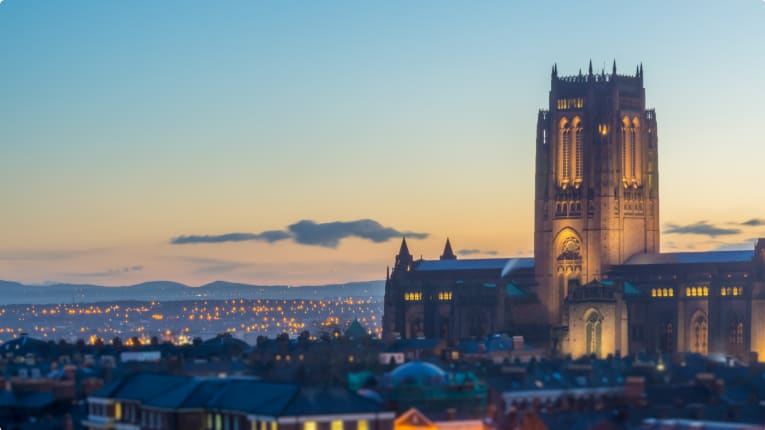
Manchester Cathedral
Manchester Cathedral was formally the medieval church of St Mary, St Denys, and St George on the banks of River Irwell in Manchester. For centuries, this was one of the largest (and wealthiest) parish churches in the land. The present church was largely rebuilt in 1421 and became a cathedral in 1847. Although it was extensively restored in 1882, the present building still retains medieval fragments within and has a gothic style and appearance.
The exterior is rich Perpendicular, outlined with strong pinnacles and extensive aisle and clerestory windows. A beautiful Mother and Child with saints (1933) by Eric Gill presides over the Dean’s entrance. Manchester’s interior is commonly claimed to have the widest nave of any cathedral in England. The cathedral once boasted eight chantry chapels in its side aisles, but today most of their screens are gone, so the chapel spaces merge into the nave.
A German bomb in 1940 destroyed most of the north-east part of the cathedral and shattered all the Victorian glass. Today, the west wall is dominated by give windows created by Antony Holloway from the 1970s to the 1990s. They depict the Creation, the Revelation, St George, St Mary, and St Denys.
The Tudor choir stalls have canopies that display some of the finest medieval woodwork in England. Within the choir stalls, the desks are decorated with figures, foliage, and shields, while below are original misericords. Their themes are the familiar quarrelling couples, thieving foxes, fighting lions and men playing backgammon.
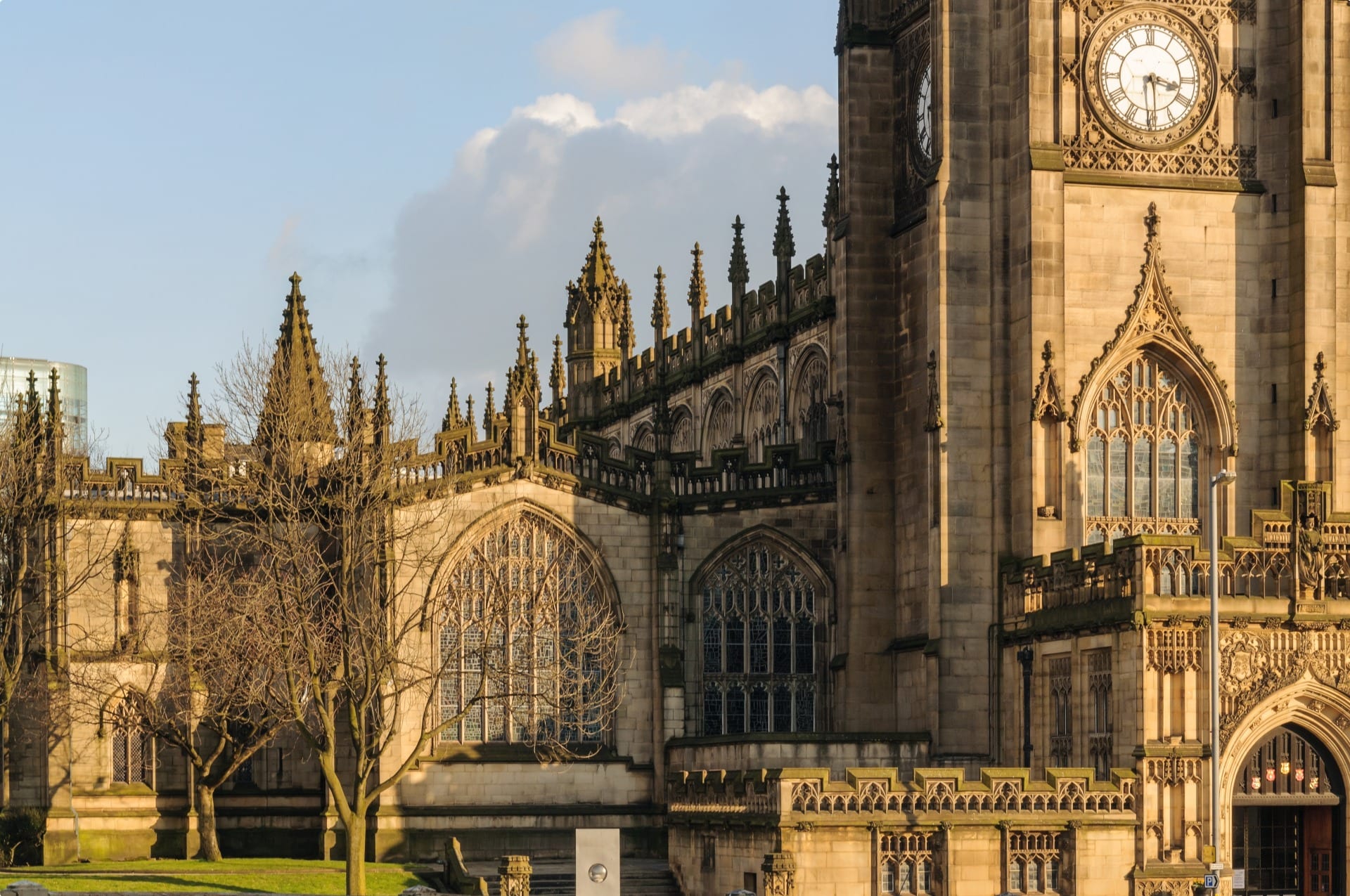
Newcastle Cathedral
Newcastle Cathedral, formally the Cathedral Church of St Nicholas, is an Anglican cathedral in Newcastle upon Tyne. The Norman church on the site was originally founded in 1091 but destroyed by fire in 1216. The current building was completed in 1350, constructed mostly in the Perpendicular style. Scottish invaders badly damaged the church’s interior during their brief occupation of the city in 1640, and they threatened to bombard the tower during the Civil War but were deterred when the English filled the tower with Scottish prisoners. The tower was repaired in 1645, 1723, and 1761, and the exterior of the church was largely rebuilt by George Gilbert Scott in 1872. It was raised to cathedral status in 1882.
The cathedral is modest in proportion. The exterior, in warm Northumberland stone, is cruciform, Perpendicular, and heavily restored. Its tower is noted for its unusual 15th century lantern spire: at the tower’s parapet, heavy buttresses become pinnacles which become much larger pinnacles and then four flying ogival ribs supporting a lantern. The lantern is a miniature steeple that roughly replicates the one below.
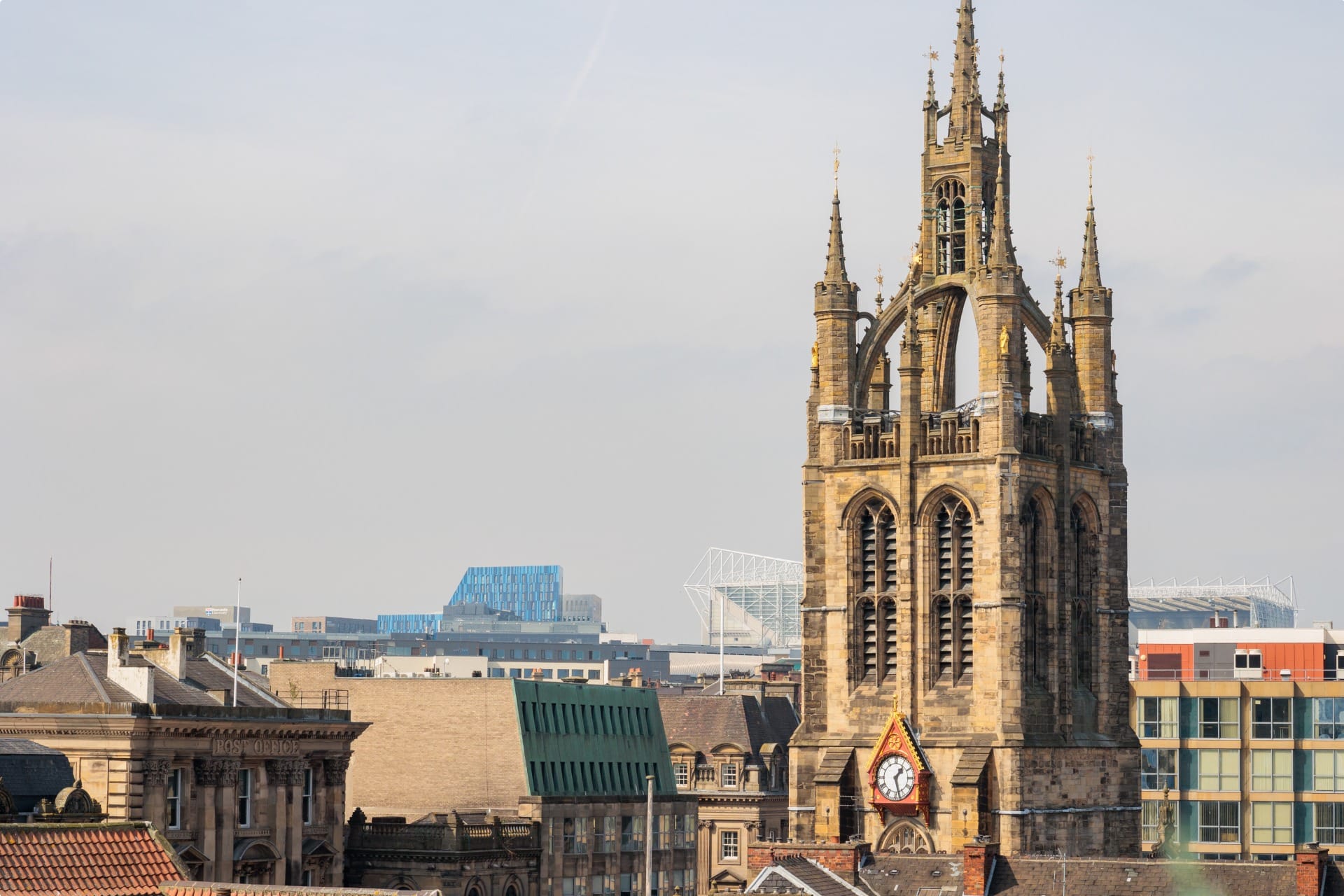
On the interior, the short Perpendicular arcade of the cathedral’s nave has shallow moulded arches and piers with no capitals. A contrasting, highly ornamental font is situated at the west end. The crossing is spacious, and the north transept filled by an enormous organ case of 1676. The chancel dates from the 1880s elevation to cathedral status. It was refurbished by local architect Robert Johnson, with the choir, its stalls and surrounding screens all crafted to evoke the late-Perpendicular era.
The cathedral contains a large collection of beautiful stained glass, mostly from the Victorian and later eras. The windows in St. George’s Chapel, for example, were erected in honour of two Tyneside shipping magnates who both died in 1931. The Ascension Chapel is overseen by a monumental work of cubist glass by Leonard Evetts (1962) celebrating the cathedral’s survival of the war. And the crypt off the north transept contains charming windows depicting Tyneside life between the wars by Basil Barber.
Newcastle Roman Catholic Cathedral
The Catholic Cathedral of St Mary’s sits on a wide plinth opposite Newcastle’s railway station, its slender spire visible from across the Tyne. It is one of the least altered of Augustus Welby Pugin’s Catholic Emancipation churches. Built between 1842 and 1844, it is a fine example of the Gothic Revival style of architecture championed by Pugin. In 1850 it was converted into a cathedral for the new diocese of Hexham and Newcastle.
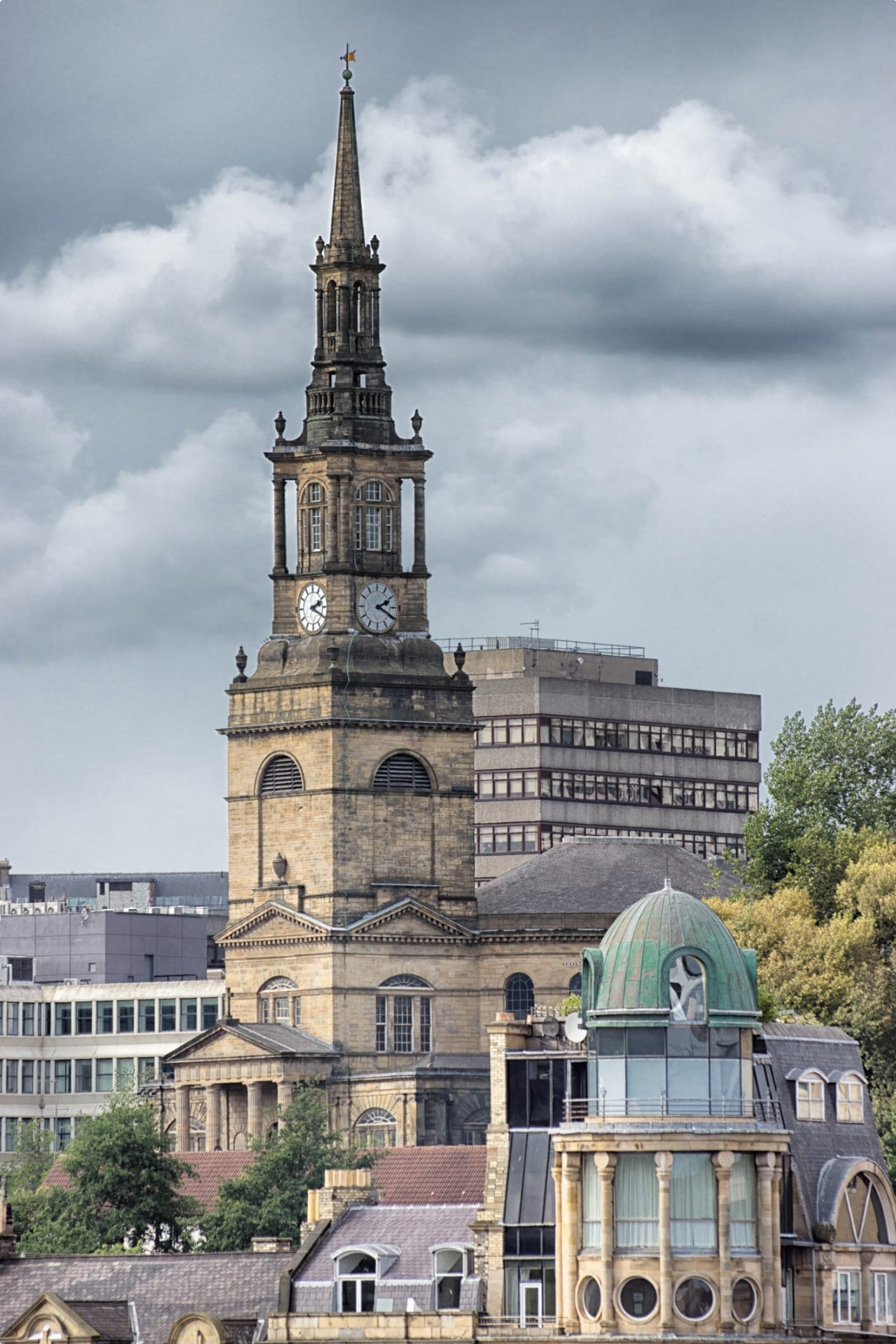
Pugin’s command of space and interior can be seen in its interior. The nave and chancel arcade are as one, with seven arches from end to end. There is no clerestory, but instead a steeply gabled wooden roof. The roof is painted in red and black, with beams and struts picked out in white spirals.
The furnishings are almost all by Pugin. Most notable is the triple-gabled high altar, carved from Caen stone with carved relief panels, as well as a lectern and a bishop’s throne. The east end is enlivened by vigorous repainting, mostly in maroon and green from Pugin’s original pattern book. The modern floor tiles are based on medieval patterns. Most of the stained glass is by Pugin or in his style.
St Paul’s Cathedral
Standing on Ludgate Hill, at the highest point of the City of London, St Paul’s has always been the city’s guardian, dominating the horizon until the property boom in the second half of the 20th century. It is believed that the first Anglo-Saxon cathedral on this site dedicated to St Paul was built in 604, founded by Bishop Mellitus of the East Saxons. The present structure’s predecessor was the fourth St Paul’s, generally referred to as Old St Paul’s, begun by the Normans after a 1087 fire. It too was badly damaged in the Great Fire of London in 1666 and had to be entirely rebuilt. For a further three centuries, the structure’s baroque architecture made it the only English cathedral building not dating from the Middle Ages.
St Paul’s was the first cathedral in England by a named architect, assigned to Sir Christopher Wren. His plans were approved in 1675, and work was carried out until 1710, resulting in what is still the second largest church in Britain. The cathedral was built from the purest of white Portland stone. Its famous dome has been proclaimed as the finest in the world.
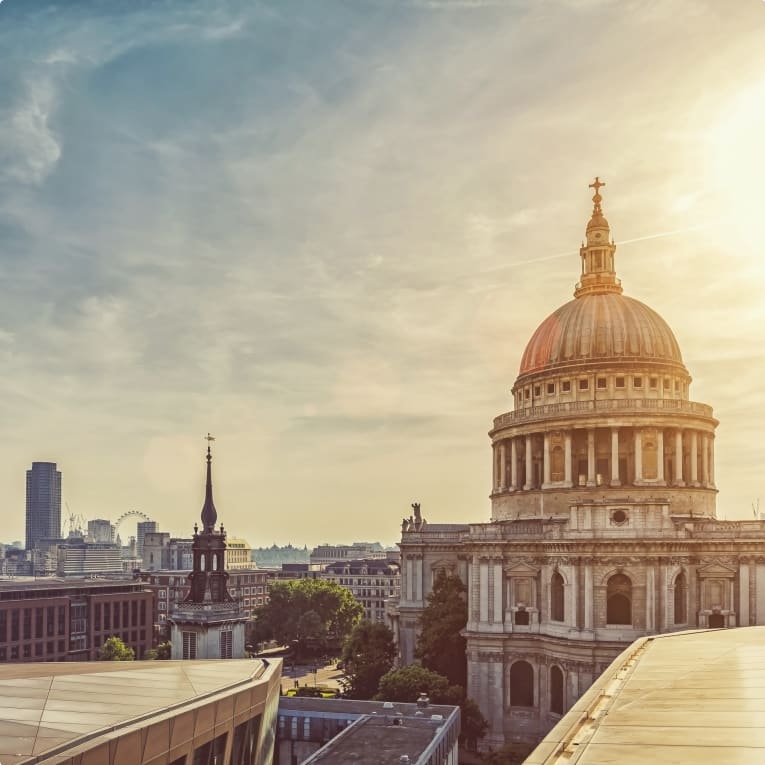
The interior appears as if it is a vast palace. An arcade of four large bays with shallow saucer domes strides from the west end to the crossing, before continuing east with splendid decorations. The crossing is the climax, an overlap of circular and rectangular planes, creating a contrast of darkness and light. The dome is painted with copies of James Thornhill’s original monochrome murals of the life of St Paul. In the triangular spaces below them are the mosaics of prophets by B. Stevens and G. F. Watts. The nave and transepts are lined with memorials to military and political heroes (and an occasional heroine). East of the crossing lies the presbytery, its vault decorated with mosaics.
The crypt of St Paul’s covers almost the same floor space as the cathedral above. At its core is the shrine of Admiral Lord Nelson, reached after passing a screen erected in memory of Sir Winston Churchill. Other memorials are less militaristic, to Sir Joshua Reynolds, J. M. W. Turner, Sir John Everett Millais, William Blake, and Florence Nightingale, amongst others. Wren himself is buried in a south aisle outside the Chapel of St Faith.

Westminster Abbey
Westminster Abbey, one of England’s most notable religious buildings, is located in the City of Westminster, London, just to the west of the Palace of Westminster. Its site is that chosen for a Benedictine monastery founded in the 960s. King Edward the Confessor founded the present abbey, beginning building in the 1040s to provide himself with a burial church. The building was completed in 1066 and every monarch since William I has been crowned at Westminster. What we see today is a 13th century rebuild by Henry III inspired by the French abbeys of Amines and Rheims. Completed over 40 years from 1245, it marked the arrival in England of Decorated gothic, defined by tall roofs, elaborated arcades, and the appearance of bar tracery on the windows.
Remarkably, the abbey has changed little since then. Henry VII’s Chapel was added in the 16th century, with a burst of Tudor panels, turrets, and pinnacles. This was followed in the 18th century by Hawksmoor’s peculiar west towers, a stylistic mix of gothic fenestrations punctured by classic cornices and baroque clock openings. Embellishments have also been added, most notably by George Gilbert Scott. Nevertheless, the Westminster we see today is essentially Henry III’s.

The interior of the abbey is in two parts. The first, to the west, is the familiar ceremonial church, the other to the east is a national mausoleum. The second part takes the form of a gallery of some 450 tombs, monuments, and memorials cramming every inch of space. The nave is unusual in its shortness, narrower in its ratio of width to height than any other English medieval cathedral. The result is a shimmering canyon. The pulpitum is a composite work of gothic revival. It is one bay deep with a fan vault below and orchestra gallery above. The choir beyond leads into the central crossing, Henry’s stage set for the ceremonies of kingship. To the north and south are ailed transepts, dominated by large rose windows.
The crossing leads eastwards up steps to the sanctuary – the venue for coronations, royal weddings, funerals, and memorial services. Overlooking the sanctuary is Scott’s Westminster reredos of alabaster, marble, cedar, and porphyry, studded with jewels and framing a mosaic of the Last Supper by Antonio Salviati. The abbey’s eastern arm curves in an oval, containing the tombs and mausoleums of many of England’s monarchs. Until the death of George II in 1760, most kings and queens were buried in the abbey.
Westminster Roman Catholic Cathedral
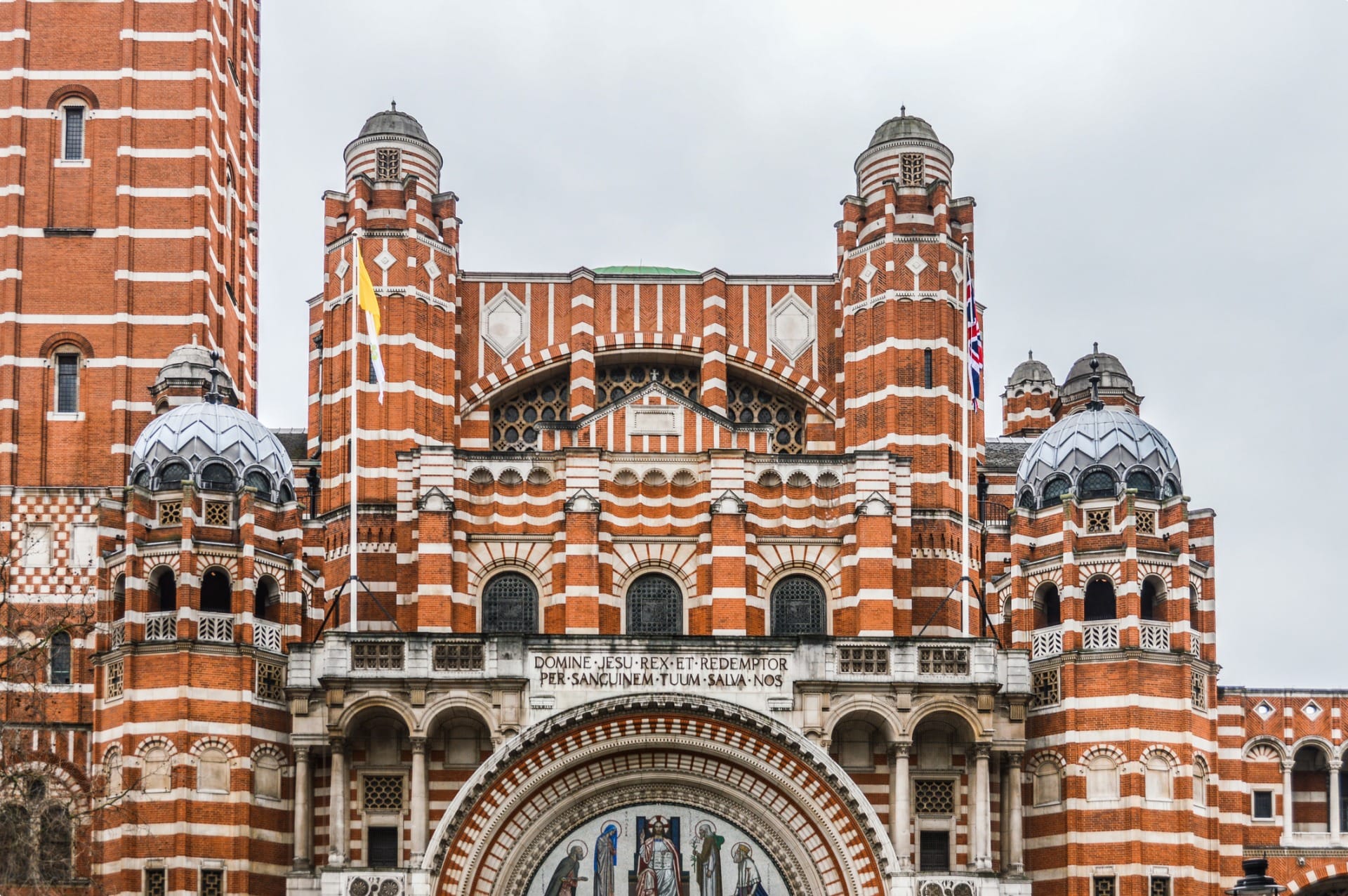
Westminster Cathedral, located in Westminster City, London, is the mother church of the Catholic Church in England and Wales. It was begun in 1895 by Cardinal Vaughan, who commissioned the architect J. F. Bentley, insisting it should be different form the abbey down the road. The result was a mix of Mediterranean styles and motifs. The campanile is Italianate, of brick with white stone bands rising to a colonnaded lantern. The west façade below, meanwhile, is more reminiscent of Byzantium, crowded with buttressed turrets, strange arches, and an over-elaborate tympanum above the west door.
The cathedral’s interior is one of London’s finest indoor spaces. Bentley composed a nave of three domed bays, followed by a larger dome crossing over the sanctuary. In the air above hovers a gigantic 30 foot cross in bright red and gold. Bentley intended the upper two-thirds of the cathedral to be covered in mosaics, but as of yet this has been left unfinished without even a lick of paint.
In contrast, the ground floor and its marble veneering is of a great richness and variety. Each arcade is subdivided into double arches, shielding galleries above. The space is ablaze with colour, with aisles and chapels glittering under the darkness above. Over 125 different marble types have been identified here, with colours of green, blue, grey, yellow, and red. Perhaps the cathedral’s most impressive feature though is its complex circuit of side chapels, with walls of marble and roofs of mosaics.
Winchester Cathedral
The cathedral in the city of Winchester is one of the largest of its kind in Northern Europe. With an overall length of 170 m, it is the longest medieval cathedral in the world. The first Christian church on the site can be traced back to c. 648, built by King Cenwalh of Wessex. The church was then greatly expanded in the 900s, with the city being the capital of Saxon England. Work begun on the cathedral that stands today as early as 1079, following the Norman Conquest. A gothic expansion then took place in the early 13th century, with the eastern arm rebuilt to meet the needs of St Swithun pilgrims, followed some two centuries later by a Perpendicular rebuilding of the nave under the patronage of William Wykeham.
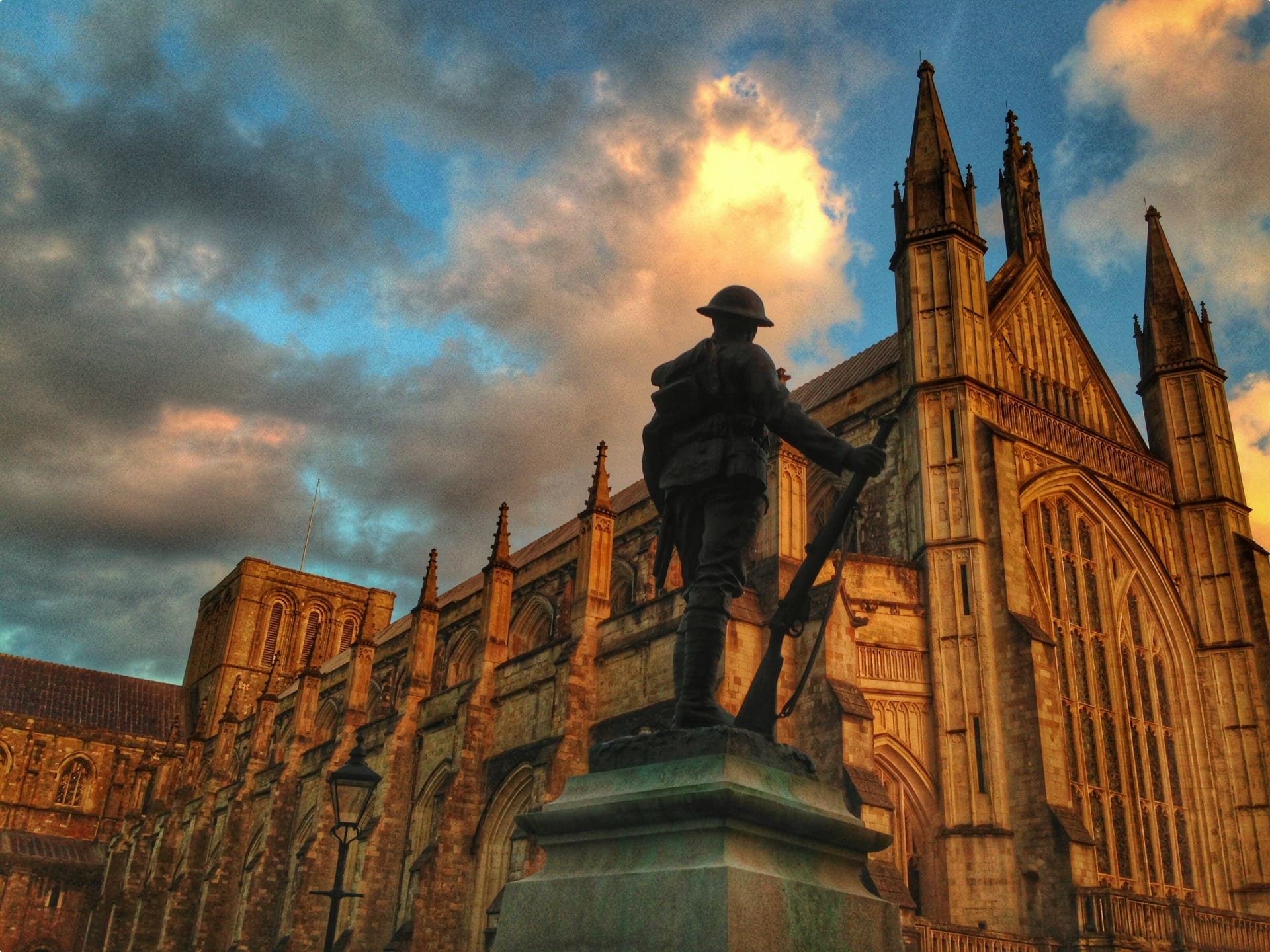
The inside view of Winchester is breath-taking. On entering, visitors are immediately confronted with Wykeham’s nave, its west wall entirely composed of tracery glass. The tracery is filled with medieval fragments and beneath stand statues of James I and Charles I. In the west bay of the nave is a font of black Tournai marble; on the nave’s south side is the jutting box of Wykeham’s chantry.
At the crossing, three tiers of arches rise to the roof, each tier a complex of single and double spans, without decoration. The north transept starts with the 12th century Holy Sepulchre Chapel whose wall paints of c. 1170 are in excellent preservation. They depict the deposition from the cross and the burial in the tomb. Also in the north transept is the Epiphany Chapel, with a set of four windows. In the south transept is the Fisherman’s Chapel. The choir screen, an immaculate gothic revival, stands as a dramatic silhouette against the presbytery beyond. The choir stalls date back to c. 1300 and include carvings depicting oak, hawthorn, ivy, and vine, as well as human faces, and birds.
Beyond the presbytery is Winchester’s retrochoir – an early Gothic chamber of clustered piers and rhythmic vaults. Built for St Swithun’s shrine, it is crowded with chapels and chantries of later bishops of the church. Much of the floor is laid with the most expensive spread of medieval tiles in England. The retrochoir is dominated by Winchester’s four principal chantries, each a distinctive example of late Gothic design.
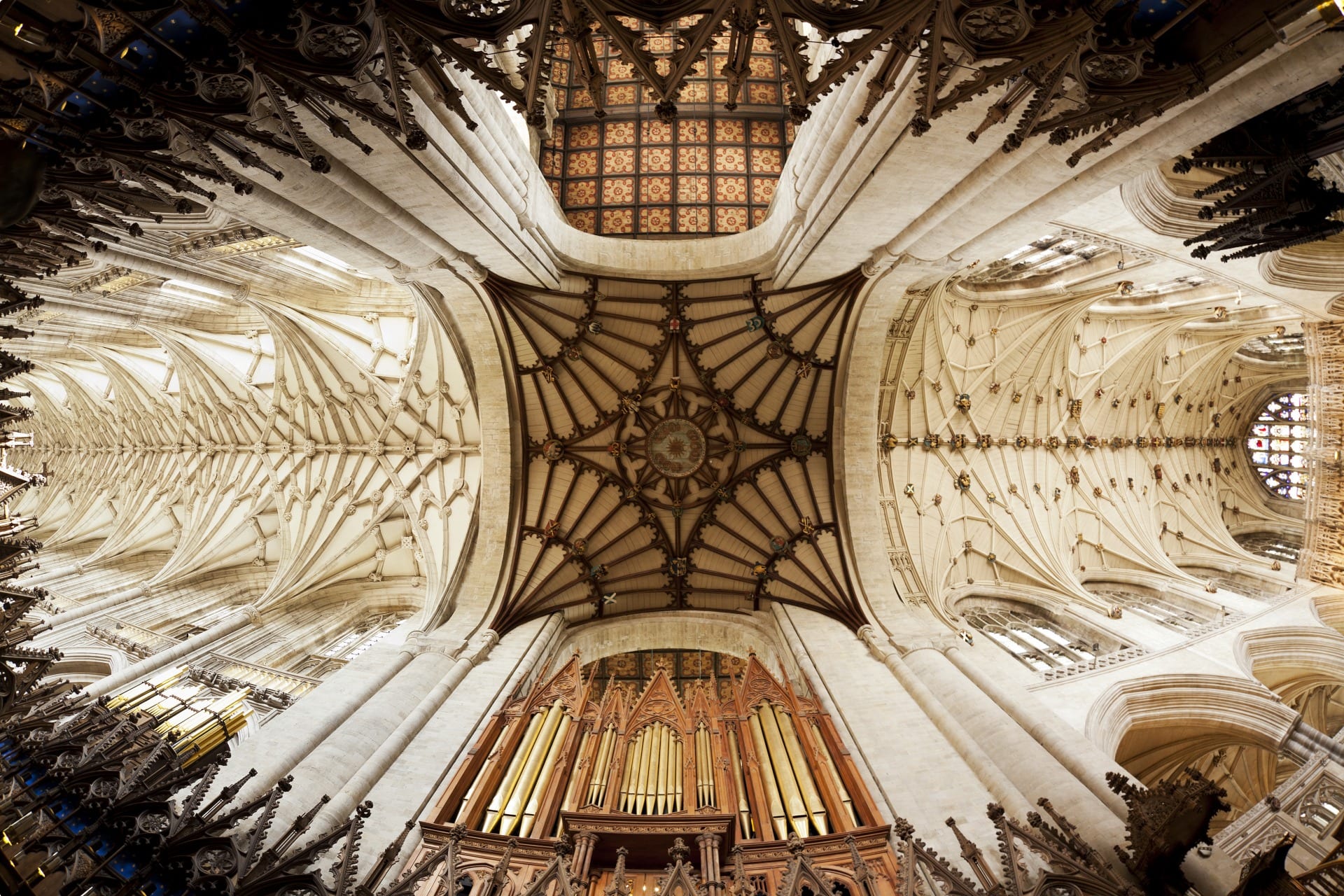
Worcester Cathedral
Worcester Cathedral sits on a bank overlooking the River Severn in the city of Worcester. A cathedral was first founded here in 680 under the Saxons. The last Anglo-Saxon bishop of Worcester, Wulfstan, was the only bishop to survive the Norman Conquest unscathed, collaborating with the Norman invaders by championing their religious discipline and commitment. As such he was able to remain bishop here and keep alive the language and culture of Ango-Saxon scholarship. He was unable to resist the Norman’s craze to rebuild, however, and is said to have wept as his old cathedral was demolished. Work on the present cathedral began in 1084 and continued until 1504.
The cathedral is a representation of every English style of architecture, from its Norman crypt to its transitional west nave, Early Gothic presbytery, Decorated nave, and Perpendicular tower. It was also massively restored in the 19th century, again mostly by George Gilbert Scott, to the extent that the east end is essentially Victorian.

Underneath the church is the famous Wulfstan’s crypt – one of the loveliest crypts in England. Some of its pillars are thought to have survived form the Saxon church, while its Norman arches are tall and mark out a curved ambulatory at the east end. The crypt contains the royal tombs of King John and Prince Arthur. The cathedral is also famous for its Norman chapter house, believed to be the first circular chapter house in the world, dating from the early 12th century.
York Cathedral
Commonly known as York Minster, the cathedral in York is the largest Gothic church by volume in England and one of the largest in Northern Europe. The first church on the site was built in 627 to baptise the former pagan King Edwin of Northumbria. When the Romans later triumphed over the Ionians in 664, York became the seat of the Roman church in the north, but it remained a minister and never a monastery. York was always politically significant. Its archbishop, Ealdred, crowned both Edward the Confessor and Harold Godwinson and was summoned to crown William the Conqueror in 1066. The church was rebuilt in the 1080s in the Norman style. The building of the gothic structure here began in the mid-12th century to rival Canterbury Cathedral and continued into the 15th century.
Celebrated views of the exterior of the cathedral are from the city walls, but there are also equally rewarding ones of its towers, buttresses, and windows from the surrounding streets. The exterior of the south transept exterior is especially extraordinary, with four ungainly tiers of lancets rising to the gable. On the west front, the dominant feature is the celebrated west window, known as the Heart of Yorkshire and a favourite backdrop to York wedding groups.

On the inside, the visitor is met with an astonishing initial view. Here is the largest interior volume in medieval England, a high point of the Decorated era but with hints of the Perpendicular style. Shafts rise uninterrupted from floor to roof, and the triforium merges stylistically into the clerestory, creating a single, vertical panel.
The transepts are both Early Gothic and dominated by their windows. Most celebrated, in the north transept, is the Five Sisters window, dating from 1255. York’s central crossing, meanwhile, embraces an exhilarating tower vault, its roof of elegant fans seeming to float on a cloud of light from side windows. The pulpitum below displays fifteen statues of monarchs. The east end barely exists, with no real retrochoir and only a brief burst of Perpendicular in the eastern transepts. Instead, all eyes turn up to the east window, at 1680 sq ft reputedly the largest expanse of medieval glass in the world.
York’s chapter house is the largest and most impressive in England. Its windows serve as the upper walls themselves, rather than opening in the walls. There are seven in number, each carrying geometrical tracery of great subtlety. Beneath are stone stalls and their canopies, each flanked by freestanding Purbeck shafts that rise to an octagonal crown with gables. Above the canopy are sculptured heads, representing some of the finest Gothic sculpture in the country.
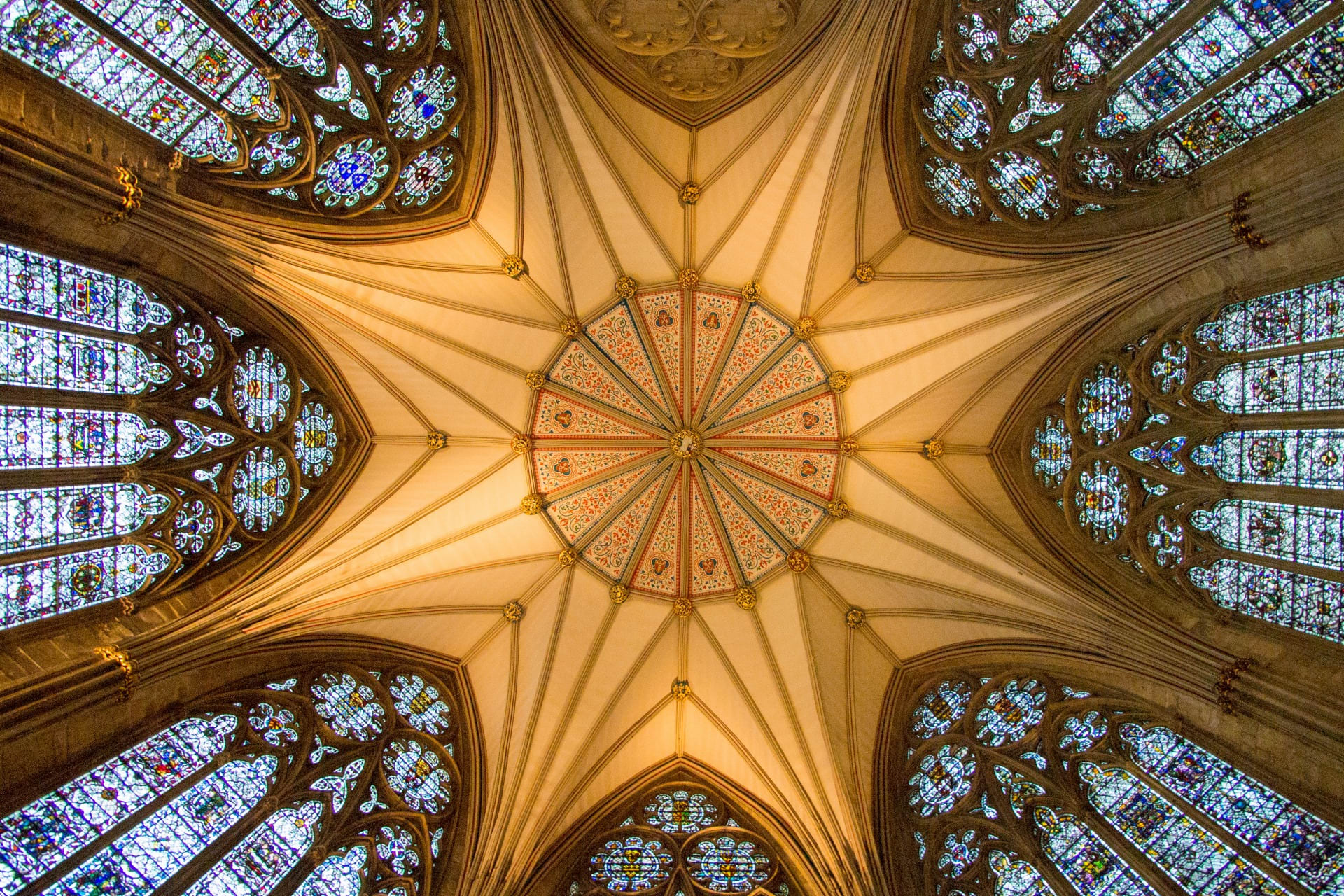
Tour of England’s Cathedrals
Odyssey Traveller visits several of England’s medieval cathedrals during our various small group tours of the country for mature and senior travellers. During our Seven Ages of Britain Tour, you will be amazed by the splendour of Norman cathedrals in Durham, York, Ely, and Norwich, as well as the views of London’s Westminster Abbey and St Paul’s Cathedral. You can also marvel at some of Europe’s most amazing cathedrals including Wells Cathedral, Ely Cathedral, and Canterbury Cathedral during our Medieval England Tour. Other cathedrals we enjoy visiting on this tour include Salisbury Cathedral, Bristol Cathedral, Hereford Cathedral, Leicester Cathedral, Norwich Cathedral, Winchester Cathedral, and Worcester Cathedral. We also view Liverpool Cathedral, the world’s largest Anglican cathedral, during our Liverpool, Newcastle, Glasgow Tour.
If you’re more interested in visiting St Paul’s Cathedral, Windsor Castle and St George’s Chapel, or the landscapes of the Cotswolds, don’t click away! Odyssey Traveller offers a number of tours of Great Britain, ranging from basic sightseeing tours ideal for your first trip, to unique experiences that delve deep into Britain’s history and culture.
Odyssey Traveller has been serving global travellers since 1983 with educational tours of the history, culture, and architecture of our destinations designed for mature and senior travellers. We specialise in offering small group tours partnering with a local tour guide at each destination to provide a relaxed and comfortable pace and atmosphere that sets us apart from larger tour groups. Tours consist of small groups of between 6 and 12 people and are cost inclusive of all entrances, tipping and majority of meals. For more information, click here, and head to this page to make a booking.
Articles about Britain published by Odyssey Traveller.
- Understanding British Churches
- Studying Gargoyles and grotesques
- Georgian Architecture
- London’s Victorian Architecture
- Traveller’s Guide to Medieval England
- Landscapes of Medieval England
For all the articles Odyssey Traveller has published for mature aged and senior travellers, click through on this link.
External articles to assist you on your visit to Britain.
Related Tours

22 days
Apr, SepSmall group tours Medieval England
Visiting England
A small group tour of England focused on Medieval England and Wales. Spend 21 days on this escorted tour with tour director and local guides travelling from Canterbury to Cambridge, passing through Winchester, Salisbury, Bristol, Hereford and Norwich along the way. Castles, villages, Cathedrals and churches all feature in the Medieval landscapes visited.
From A$14,665 AUD
View Tour
22 days
Apr, AugSeven Ages of Britain, snapshots of Britain through the ages.
Visiting England, Scotland
This guided small group tour starts in Scotland and finishes in England. On Orkney we have a day tour to the UNESCO World heritage site, Skara Brae, before travelling to city of York. Your tour leader continues to share the history from the Neolithic to the Victorian era. The tour concludes in the capital city, London.
From A$15,995 AUD
View Tour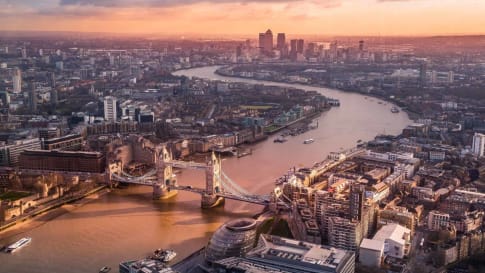
6 days
Apr, SepLondon Short Tour
Visiting England
A small group tour of London is a collection of day tours that visit and explore through the villages of the city. This escorted tour includes a journey out to Windsor castle. We explore Contemporary and learn about Roman Walled city, Medieval, Victorian London and the contemporary city today.
From A$6,995 AUD
View Tour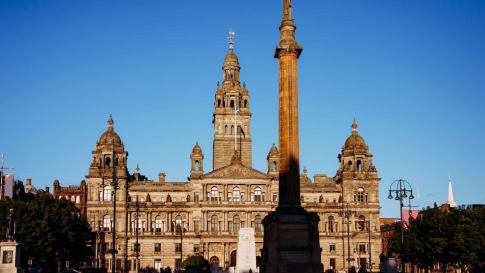
From A$13,915 AUD
View Tour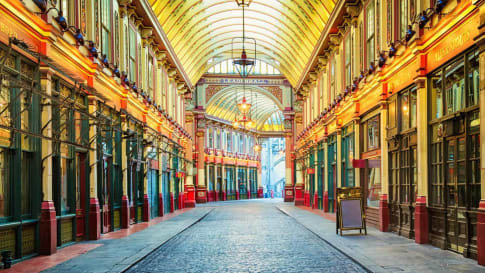
21 days
Sep, JunQueen Victoria's Great Britain: a small group tour
Visiting England, Scotland
A small group tour of England that explores the history of Victorian Britain. This escorted tour spends time knowledgeable local guides with travellers in key destinations in England and Scotland that shaped the British isles in this period including a collection of UNESCO world heritage locations.
From A$15,880 AUD
View TourRelated Articles

British Village Icons: Definitive Guide for Travellers
Icons of the British Villages: Pubs and Cottages The British pub and cottage figure prominently in the image of a (often romanticised) quintessential “British village”. In this article, we will give special attention to these…

Discovering Medieval Chester: A Thriving Trade Centre
Article about Chester, England for small group educational tours for senior couple and mature solo travellers to England. Articles to support your travel plans to explore England, Scotland, Wales and Ireland.
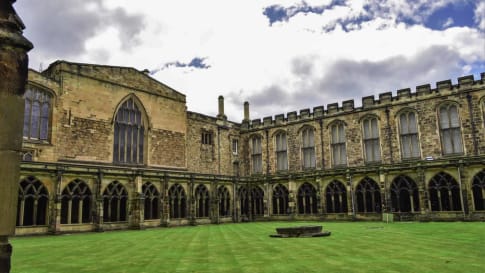
Durham, England
Durham is a city steeped in history and packed full of hidden gems. Explore this UNESCO World Heritage city on Roaming Rural England . This small group has a guided visit of Durham Cathedral and walks the city.
England's Liverpool: Port City, Architecture Marvel
Article for educational small group tours about the Port City of Liverpool. An Architecture Marvel from Georgian times, built on trade, some good, some horrific. Read and learn more before joining a tour for senior couples and mature solo travellers interested in culture, learning and the arts.

Exploring Newcastle upon Tyne: The Definitive guide for Travellers
Newcastle upon Tyne is discussed in this article for senior couples and mature solo travellers on an educational small group tour. Learn about this English city and the Romans, Vikings, Middle ages and Victoria and the Industrial revolution.
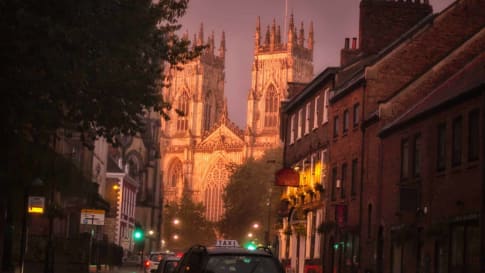
Exploring York
Article about York, England. Explored on a small group educational tour for senior couples and mature singles curious about history from the Romans, the Vikings and the industrial revolution. Including the famous York Minster a great cathedral!

Medieval British Village Life: The Definitive Guide for Seniors
Life in the Medieval British Village In a previous article, we looked at the icons of the British village–the pub and the cottage–and looked at their history and evolution from Roman and Norman times. In…
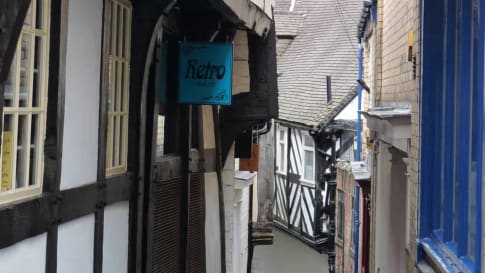
Shrewsbury, England
Article about Shrewsbury for senior couples and mature solo travelers joining an escorted small group tour in England or Britain. Learn about medieval Britain and the industrial revolution in this town.
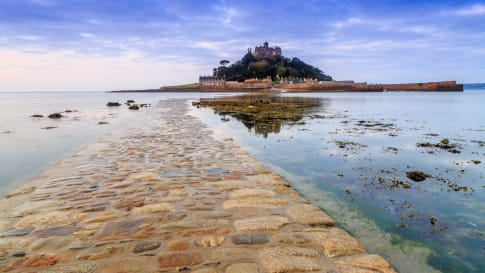
St Michael's Mount, England
The counterpart to Mont St Michel. On the Devon and Cornwall escorted small group tour for senior and maturer travellers the group learn about the abbey of St Michael's mount built in the middle ages complete with gargoyles and grotesques.

Studying Gargoyles and Grotesques: The Definitive Guide for Travellers
Article to support world travellers since 1983 with small group educational tours for senior couples or mature solo travellers interested in British and European history.

Understanding British Churches: The Definitive Guide for Travellers
British Churches Through the Years “How old is this church?” asks Mary-Ann Ochota in a chapter of her book, Hidden Histories: A Spotter’s Guide to the British Landscape (Francis Lincoln, 2016, p. 250). In this article, we…


